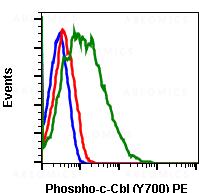
Fig-1: Flow cytometric analysis of C6 cells cell only only negative control (blue) or treated with imatinib (red) or with pervanadate (green) using Phospho-c-Cbl (Tyr700) PE-conjugated antibody CblY700-E1.
| Format : | Conjugated |
| Amount : | 100 Tests |
| Isotype : | Rabbit IgG1k |
| Content : | 1X PBS, 0.09% NaN3, 0.2% BSA |
| Storage condition : | Store at 2-8°C. Avoid repeated freeze and thaw cycles. |
| Alternative Name : | E3 ubiquitin-protein ligase CBL, Casitas B-lineage lymphoma proto-oncogene, Proto-oncogene c-Cbl, RING finger protein 55, RING-type E3 ubiquitin transferase, Signal transduction protein CBL, CBL2, RNF55 |
| Immunogen Information : | A synthetic phospho-peptide corresponding to residues surrounding Tyr700 of human phospho c-Cbl |
For flow cytometric staining, the suggested use of this reagent is 5 µL per million cells or 5 µL per 100 µL of staining volume. It is recommended that the reagent be titrated for optimal performance for each application.
For Research Use Only. Not for use in diagnostic/therapeutics procedures.
| There are currently no product reviews |